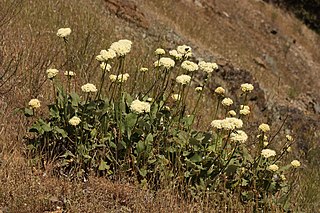
Eriogonum is a genus of flowering plants in the family Polygonaceae. The genus is found in North America and is known as wild buckwheat. This is a highly species-rich genus, and indications are that active speciation is continuing. It includes some common wildflowers such as the California buckwheat.

Eriogonum nudum is a perennial shrub of the wild buckwheat genus which is known by the common name naked buckwheat or nude buckwheat.

Eriogonum fasciculatum is a species of wild buckwheat known by the common names California buckwheat and flat-topped buckwheat. Characterized by small, white and pink flower clusters that give off a cottony effect, this species grows variably from a patchy mat to a wide shrub, with the flowers turning a rusty color after blooming. This plant is of great benefit across its various habitats, providing an important food resource for a diversity of insect and mammal species. It also provides numerous ecosystem services for humans, including erosion control, post-fire mitigation, increases in crop yields when planted in hedgerows, and high habitat restoration value.

Eriogonum alpinum is a species of wild buckwheat known by the common name Trinity buckwheat.
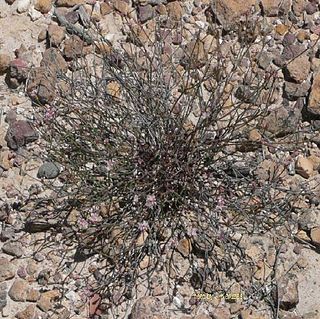
Eriogonum apricum is a rare species of wild buckwheat known by the common name Ione buckwheat. It is endemic to Amador County, California, in the United States.

Eriogonum arborescens is a species of wild buckwheat known by the common name Santa Cruz Island buckwheat.
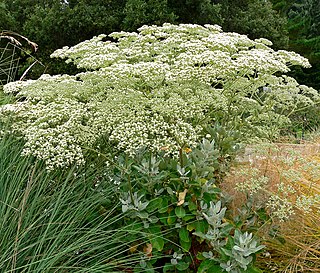
Eriogonum giganteum, with the common name St. Catherine's lace, is a species of wild buckwheat in Southern California.

Eriogonum ovalifolium is a species of wild buckwheat known by the common name cushion buckwheat. It is native to western North America from California to Alberta, where it is a member of many plant communities in varied habitats, including the sagebrush steppe and alpine regions.
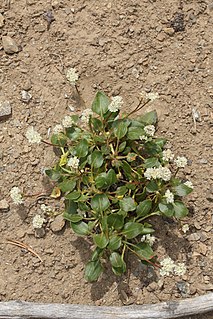
Eriogonum pyrolifolium is a species of wild buckwheat. It is native to western North America, from British Columbia to the high mountains of California.
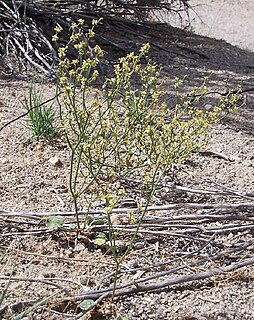
Eriogonum ampullaceum is a species of wild buckwheat known by the common name Mono buckwheat.

Eriogonum angulosum is a species of wild buckwheat known by the common name anglestem buckwheat.
Eriogonum argillosum is a species of wild buckwheat known by the common names clay buckwheat, clay-loving buckwheat, and Coast Range wild buckwheat. It is endemic to California, where it is known only from San Benito and Monterey Counties. It grows on clay substrates, often of serpentine origin. This is an annual herb up to 30 to 60 centimeters tall with a basal patch of oval-shaped, woolly leaves and a naked stem. The top of the stem is occupied by the inflorescence, a cyme with several clusters of tiny white or pink flowers.

Eriogonum baileyi is a species of wild buckwheat that is commonly known as Bailey's buckwheat. It is native to the western United States, where it is a common member of the flora in several types of sandy habitat, such as desert and sagebrush. Eriogonum baileyi is an annual herb. It produces a spreading to erect, often wool-coated stem up to about half a meter tall. Leaves are woolly, round and located at the base of the plant. The inflorescence is a branching cyme bearing many clusters of flowers. The individual flowers are 1 to 2 millimeters wide and white or pink in color.

Eriogonum brachyanthum is a species of wild buckwheat that is commonly known as shortflower buckwheat. It is native to eastern California and western Nevada, particularly the Mojave Desert region, where it is common to abundant, and even sometimes weedy. It is also known from southern Oregon. The plant grows in sandy habitats such as desert flats and sagebrush. It also grows in pinyon-juniper and montane conifer woodlands. It is an annual herb that grows 30 to 40 centimeters tall. Leaves are located at the base of the stem, woolly, and oval or rounded in shape. The top of the stem is occupied by a branching inflorescence bearing many widely spaced clusters of flowers. Each individual flower is about a millimeter wide and light yellow in color. Flowers bloom from April to November.
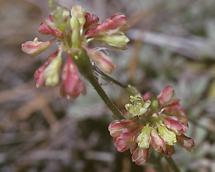
Eriogonum kelloggii is a rare species of wild buckwheat known by the common names Red Mountain buckwheat and Kellogg's buckwheat. It is endemic to Mendocino County, California, where it is known from only five occurrences on Red Mountain near Leggett. It grows in woodland habitat on serpentine soils.

Eriogonum kennedyi is a species of wild buckwheat known by the common name Kennedy's buckwheat.
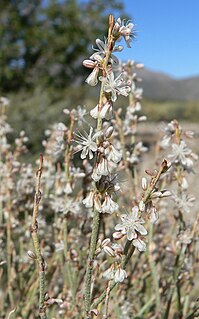
Eriogonum panamintense is a species of wild buckwheat known by the common name Panamint Mountain buckwheat. It is native to several of the desert mountain ranges of eastern California and western Nevada, including the Panamint Range. It grows in various types of mountain ridge habitat, such as sagebrush and coniferous woodland.

Eriogonum siskiyouense is a rare species of wild buckwheat known by the common name Siskiyou buckwheat.

Orobanche californica, known by the common name California broomrape, is a species of broomrape. It is a parasitic plant growing attached to the roots of other plants, usually members of the Asteraceae.

Eriogonum callistum is a rare species of wild buckwheat, known by the common name Tehachapi buckwheat.




















